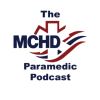In this episode of the MCHD Paramedic Podcast, we discuss something a little different from your typical medicine, but something that is crucial to patient management – and that is anchoring bias (i.e., becoming overly attached to a diagnosis even if there is contradicting evidence).
EM/EMS Physician Dr. Katherine Luu joins the podcast to discuss anchoring bias and how this impacts medics in the field, sharing the following example of how dangerous anchoring bias can be:
I learned this painfully as an ER resident working Halloween night. It happened to be Saturday night with a full moon and the end of daylight savings, so it was an extra hour of madness. I had already seen multiple intoxicated patients that night when EMS brought a 26 y/o male dressed as a pirate coming in for “intoxication and a fall while at a party.” No one was actually sure what happened, they just noticed him passed out on the ground.
On exam he was hemodynamically stable, awake but still intoxicated and agitated. He followed some commands and moved all extremities. Fingerstick was normal. Head imaging crossed my mind, but he was young and stable, so I was going to let him sleep it off and reassess. Fast forward 4 hours later and nurses report the patient was getting more somnolent and confused.
Head CT showed an intracranial bleed. Luckily, it was small and non-surgical, but I will never forget the drunk pirate as I anchored too soon on intoxication and nearly missed the head bleed.
Listen in as we break down some key principles on medical decision making and what you can do to avoid having your own drunk pirate, as we discuss:
- Be a medical detective, ask more questions when it doesn’t make sense.
- Reconsider the differential constantly. Does it fit? What else could it be?
- Vital signs are vital for a reason. Revisit not just the patient, but also the differential when there is a sudden change.
Read more:
How anchoring can cause medical errors
EMS providers need to understand anchoring, a type of cognitive bias, to prevent errors in prehospital patient assessment and care




